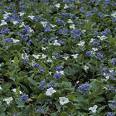
The spring ephemerals grow quickly while conditions are especially favorable for them. They have a high photosynthetic rate that allows them to use the light available on the forest floor while the trees are bare. By the time the leaves cover the trees and block the light they have completed the reproductive phase of their life cycle and go dormant, living off food stored in their underground organs. Conditions other than light are also optimal at this time. Soil moisture is high due to spring rains and the fact that the leafless trees are not soaking up large quantities of water. In addition, the soil is rich in nutrients from the addition of organic matter in the form of decayed leaves.

Another spring ephemeral with recurved petals is Shooting Star (Dodecatheon sp.) It bears it nodding white, rose or purple flowers in rounded clusters above basal leaves. 
The stamens are joined to create a beak-like projection that gives the plant its name. Another interesting plant is Dutchman’s Breeches (Dicentra cucullaria). The small white flowers resemble a pair of pants, hence the name, and dangle from gracefully arched stems above lacey gray-green foliage. Wild bleeding heart (Dicentra exima) and Squirrel (Dicentra canadensis) are both white flowered cousins of Dutchman’s Breeches and also an unusual flower shape and attractive foliage. The Trilliums, (T. grandiflorum, T. luteum, and T. erectum) have three part flowers and three part coarse shiny green leaves that contrast nicely with the fine foliage of the Dicentras. Virginia Bluebells (Mertensia virginica) bear their bell shaped blue flowers in graceful nodding clusters. The buds are pink and contrast nicely with the blue flowers. Bluebells look especially nice with white trillium.
 |
 |
 |
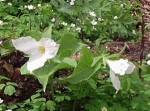 |
 |
 |
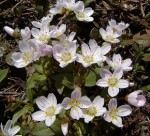
There are many other spring ephemerals that provide delicate white, pink, or blue flowers. These include Spring Beauty (Claytonia sp), Harbinger of Spring (Erigenia bulbosa), Hepatica (H. nobilis), Azure Bluet (Houstonia caerulea), Twinleaf (Jeffersonia diphylla), Bloodroot (Sanguinaria canadensis), and Rue Anemone (Thalictrum thalictroides). The shiny lobed leaves of Hepatica are especially attractive.
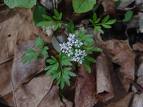 |
 |
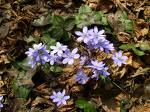 |
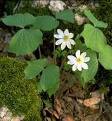 |
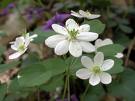 |
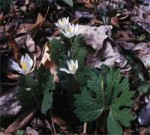 |
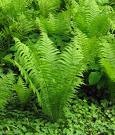
Good companion plants for spring ephemerals are other woodland species that will cover the bare spots after they have gone dormant in May or June. Native ferns are an especially good choice in this regard. Other interesting plants that go well are Jack- in-the-pulpit, Woodland Phlox, Jacob’s Ladder, Woodland Spiderwort, and Columbine.

If you choose to cultivate spring ephemerals or any wildflowers buy your plants from reputable nurseries that propagate their own plants. Harvesting the plants from the wild may endanger the plants and damage the environment. Check with your county extension service or local native plant society for sources of wild flowers.
To grow spring ephemerals successfully, pick a site that has deciduous trees to provide the proper amount of sun and shade. Prepare the soil so that it resembles good, rich forest soil by adding 4”-6” of compost to the top “4-6” of soil. The pH should be about neutral or slightly acid or slightly alkaline and water should be available to keep the soil moist(but well drained). Plant in late summer or early spring and mulch with compost every spring before the plants emerge. Remember to take a walk in your woodland in early Spring and enjoy the beauty there.
[…] KarensGardenTips.com created an interesting post today on Comments »Here’s a short outlineThe Beauty of Spring EphemeralsPosted by karen on March 24, 2009If you are lucky enough to have woodland of deciduous trees you might be enjoying spring ephemerals. These delightful plants are especially adapted to lie in the forest so that they bloom and set seed very early, before the trees leaf out, and then disappear until next year. Although they are wildflowers many can be purchased so that gardeners can enjoy them if they have a shady area in which to plant them. The spring ephemerals g […]
[…] The Beauty of Spring Ephemerals | KarensGardenTips.com […]
[…] May when the azaleas and rhododendrons are in bloom but at the same time it is a treasure trove of spring ephemerals, other herbaceous perennials, and […]